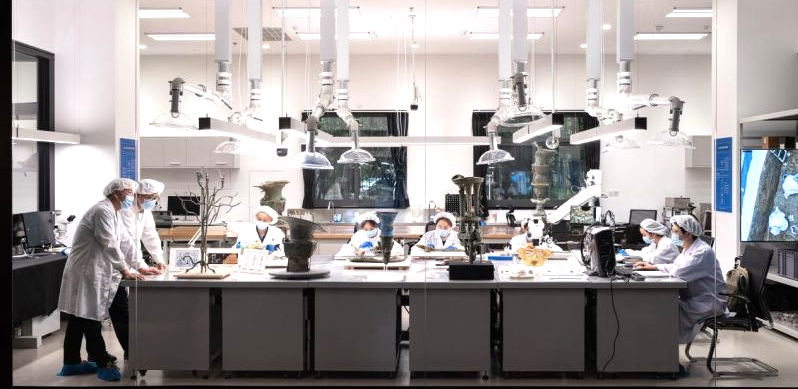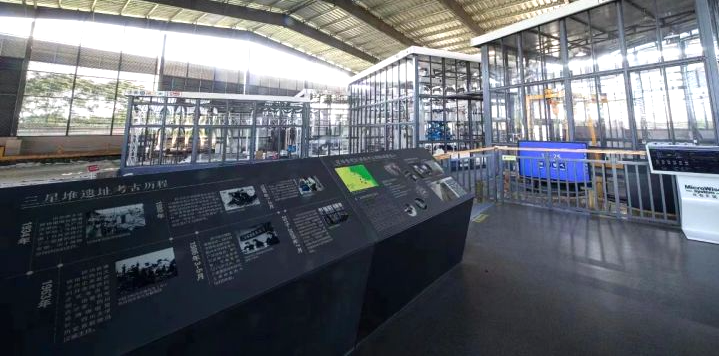By Li Kaixuan, People’s Daily
The eagerly awaited new building of the Sanxingdui Museum in southwest China’s Sichuan province was officially opened to the public on July 27, showcasing nearly 600 relics unearthed from the renowned Sanxingdui Ruins. This archaeological treasure trove includes over 1,500 pieces or sets of relics, such as pottery, bronze, jade, and gold wares, occupying an impressive exhibition area of 22,000 square meters.
The Sanxingdui Ruins is a significant archaeological site, representing the largest ruins of the pre-Qin period (pre-221 BC) in southwest China, with the longest duration and the most extensive collection of relics. It is lauded as one of the greatest archaeological findings of the 20th century. The core area of the Sanxingdui Ancient City, spanning approximately 3.6 square kilometers, dates back over 3,000 years ago to the mid- and late-Shang Dynasty (1600-1046 BC).
In recent years, advanced technologies from various disciplines have been employed in the archaeological excavations at the Sanxingdui Ruins, revolutionizing the research models of major archaeological projects and promoting interdisciplinary cooperation.
For instance, experts have used black ashes found in sacrificial pits to reveal textile techniques from over 3,000 years ago. Artificial intelligence technology has been employed to reconstruct a replica of a bronze altar using fragments from different sacrificial pits. These initiatives have shed new light on ancient cultures and craftsmanship.
Given the sensitive nature of unearthed relics, it is crucial to preserve them properly. To ensure their protection, the 2021 excavation of the Sanxingdui Ruins employed tech-ish transparent archaeological cabins equipped with temperature and humidity controllers, shielding the relics from dust, bacteria, and other pollutants. A laboratory for emergency relic protection and temporary warehouses were also set up to ensure efficient preservation.
The process of unearthing relics requires great care and precision. Archaeologists meticulously sample the soil and adhesions on the artifacts, performing tests to assess factors like pH values, soluble salt content, and moisture levels, providing a basis for unearthing and preservation efforts.
To protect large bronze wares during extraction, archaeologists have utilized 3D-printed silica gel protective cases tailored perfectly to fit the artifacts. Moreover, real-time kinematic technology has been utilized to record the geographical information, ages, and materials of the soil samples and unearthed relics. Each relic is assigned a unique QR code, acting as its “identity card.”
To reconstruct fragmented bronze wares found in different sacrificial pits, the preservation team collaborated with a digital lab under Chinese tech giant Tencent. They used artificial intelligence technology to identify the geometrical features of the fragments and verify potential combinations, restoring the original appearance of the relics in a virtual space without physical contact.
Technological advancements have also aided in the study of ancient materials. In the past, the lack of sufficient scientific and technological capabilities hindered research on many of the unearthed relics. For instance, ashes found on bronze wares were initially considered residues of silk, but technology at that time was unable to confirm this.
However, recent years have seen significant progress. The development of fibroin detection technology by the China National Silk Museum and other institutions, based on immunology, led to the discovery of silk residues in sacrificial pits at the Sanxingdui Ruins in 2021. By employing ultra-depth microscopes and micro Fourier transform infrared spectroscopy, researchers reexamined bronze wares excavated some 30 years ago, successfully confirming the presence of silk.

Researchers work in a relic’s protection and repair laboratory at the Sanxingdui Ruins site in southwest China’s Sichuan province. (Photo from the National Cultural Heritage Administration)
These technological advances have unlocked valuable insights into the textile history of Sichuan province and underscore the importance of technology in enhancing our understanding of historical artifacts.
Technology acts as a virtual microscope, allowing researchers to examine relics in greater detail, providing information that was once challenging to obtain. Recording relic information through digital means breathes new life into these ancient artifacts. Digital technology facilitates global access to relic data, fostering mutual learning among civilizations and supporting science popularization and education.
The transition of cultural relics from material resources to digital assets offers tremendous potential for the preservation and dissemination of human heritage, propelling us toward a future of increased cultural understanding and appreciation. The opening of the new building at the Sanxingdui Museum marks a significant milestone in the ongoing journey of unraveling the mysteries of the past and sharing them with the world.
Disclaimer: The opinions expressed in this article are those of the authors. They do not purport to reflect the opinion or views of the Mumbai Messenger Editorial team

Editor in Chief : Mewati SItaram











